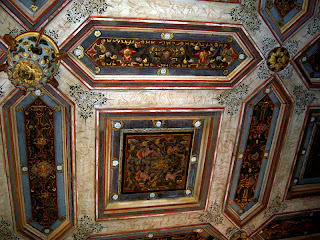This even looks moorish, as do many of the abstract designs elsewhere in the castle. We forget the frequent contacts, visits, trading arrangements, between Swedish Vikings, known as the Rus, and the Middle East. The Black Sea. Coins of varied realms. Even DNA shows up both places showing friendly contacts. They went there. They came here. Imagine.
 Moorish-shaped doorway, Kalmar Castle, Sweden
Moorish-shaped doorway, Kalmar Castle, SwedenSee Swedish Vikings heading down past Novgorod, that they founded; to Kiev; that they founded; to parts Middle East. See ://hubpages.com/hub/Rus-Vikings-Trade-Slavery-and-Conquest
 Exterior Drawbridge area, Castle Kalmar, Sweden
Exterior Drawbridge area, Castle Kalmar, SwedenKalmar was for centuries Sweden's fortress to the east, on the Baltic; a bastion against Denmark in particular, whose boundaries in medieval times extended to within a few miles of Kalmar. Its history dates back to the 9th Century.
The earliest Keep dates before 1250. Then came multiple gate towers, connected by a curtain wall.
In the 16th Century, the medieval stronghold was rebuilt into a grand palace. The BBC calls it the finest Renaissance Castle in northern Europe. See http://www.bbc.co.uk/dna/h2g2/A805862/ The original keep was demolished later, and a chapel and other facilities substituted.
The Danish King Christian IV prevailed in a battle against the Swedish King Gustavus Adolphus at Kalmar in 1611, a victory that Christian IV hoped would result in Danish control of the Baltic Sea area, but it was not decisive. With a series of later battles and treaties, and a joint concern with German Catholic expansion (Thirty Years' War era), Sweden came back. Handy history reference sites, to be carefully vetted on your own, help keep the castles straight. For this one, see ://en.wikipedia.org/wiki/Christian_IV_of_Denmark/.
In the 1700's, the castle was used primarily as a prison, and royal armory. See the BBC site. Then there was a royal distillery, with the need for venting the spirits' unneeded ordinary steam. Break through the floors!
Here: More of Kalmar inside. The vast interior --
A good defense is not offering a way in. On this door, not even a handle from this side.
 Renaissance tiled stoves, for interior heating, Castle Kalmar, Sweden.
Renaissance tiled stoves, for interior heating, Castle Kalmar, Sweden. Ducts carried the hot air to other rooms. The Renaissance ceramic tiled stove One theory is that the Renaissance in cold countries could not have flowered without the invention and proliferation of this kind of central heating.
 Women's prison bed area, Kalmar Castle, Sweden.
Women's prison bed area, Kalmar Castle, Sweden.Beds in cubbies: the better to keep warm, my dear. This is in an area used later as a women's prison -- the beds side by side, mats on planks, with graffiti on the walls. What did these ladies do to deserve this? Talk back? Don't talk back. Yakkity.....
 Cylindrical ceramic stove, heating; Kalmar Castle, Sweden
Cylindrical ceramic stove, heating; Kalmar Castle, Sweden Vent, castle still for brewing spirits below, venting up here. Kalmar Castle, Sweden.
Vent, castle still for brewing spirits below, venting up here. Kalmar Castle, Sweden.Home brew. Has to vent somewhere. Up into the castle, where it wrecked lovely walls. Hic.
 Dungeons and holding areas, when part of Kalmar was used as a prison in later years.
Dungeons and holding areas, when part of Kalmar was used as a prison in later years. All was not grim, however We are looking up the king whose mistress had her bedchamber right off the throne assembly room. Coffee, tea or me? Don't be silly. This is history.
 Mistress' bedchamber, off the side of the throne room, Kalmar Castle, Sweden
Mistress' bedchamber, off the side of the throne room, Kalmar Castle, SwedenSee Kalmar Castle via somebody's video cam at ://www.sweden.se/eng/Home/Tourism/Visuals/Panoramic-Sweden/August-2008/Kalmar-Castle/
 Storage chests, wall veneers, window seat area, Kalmar Castle, Sweden
Storage chests, wall veneers, window seat area, Kalmar Castle, SwedenColors are bright, with many abstract designs mixed with the natural.
 Ceiling, hunting scene, Kalmar Castle, Sweden
Ceiling, hunting scene, Kalmar Castle, Sweden
 Ceiling, Kalmar Castle, Sweden
Ceiling, Kalmar Castle, Sweden Sudden doors, flush to the walls, to where? Kalmar Castle, Sweden
Sudden doors, flush to the walls, to where? Kalmar Castle, Sweden Abstract patternings, knockers and locks, miinor doorways for carts from the outside, cobbled ways, Kalmar Castle, Swedenhat
Abstract patternings, knockers and locks, miinor doorways for carts from the outside, cobbled ways, Kalmar Castle, Swedenhat
No comments:
Post a Comment